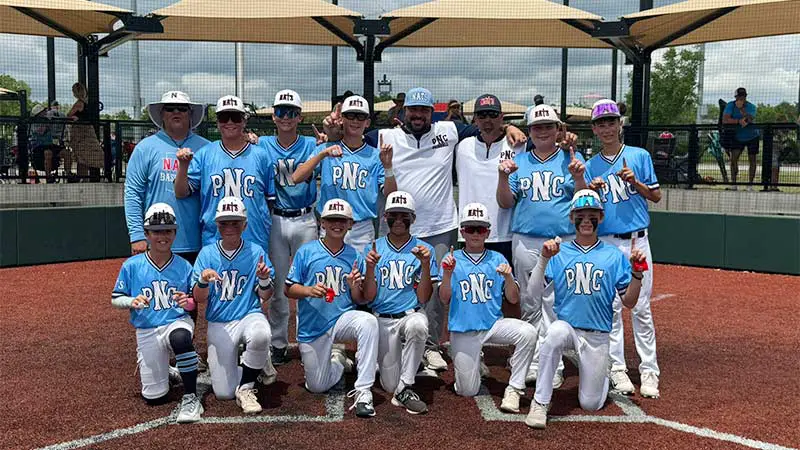If you’re navigating the world of youth baseball, understanding USSSA rules is essential. These regulations ensure fair play and safety, aligning closely with Major League Baseball standards.
Whether you’re a coach, player, or parent, knowing these rules can make a significant difference in how you approach the game.
For instance, USSSA Rule 701C outlines specific penalties for using non-compliant bats. The first offense allows the defensive team to choose the play’s outcome or call the batter out, while a second offense results in the manager’s ejection.
Additionally, starting January 1st, 2020, 13U players must use a max drop of -8, and 14U players a max drop of -5. These details highlight the importance of staying updated with USSSA regulations to ensure a seamless and enjoyable baseball experience.
Overview of USSSA Baseball Rules
USSSA (United States Specialty Sports Association) baseball has its own set of rules and regulations that govern gameplay.
Here’s a general overview:
Key Changes for the Current Season
USSSA Baseball often implements updates to enhance gameplay and safety. For the current season, notable changes include stricter enforcement of the Pitchers Mandatory Runner Rule.
You’ll find that any misuse of this rule results in immediate removal of the manager or coach. Additionally, the Metal Cleats Rule prohibits the use of metal spikes on turf fields across all age groups to prevent field damage and enhance safety.
Players caught using metal cleats face immediate ejection. Expect updated bat regulations, particularly for age groups 13U and 14U, where stricter bat rules may apply as indicated on the event website or game schedule.
The Rulebook Structure
The USSSA Baseball rulebook comprises several key sections designed to ensure fair and safe play. The Player Equipment section outlines specifications for bats, gloves, and other equipment, ensuring compliance with USSSA standards.
The Gameplay Mechanics section covers detailed gameplay rules, including intentional walks, courtesy runners, and sliding protocols.
For instance, an intentional walk can be issued upon the pitcher’s or catcher’s announcement without throwing pitches, streamlining the process during games.
The Regulations on Conduct section details acceptable player, coach, and fan behavior, with strict policies for removal and fines to ensure a respectful game environment. Compliance with these structured rules creates a smooth and enjoyable baseball experience.
Game Regulations
In USSSA baseball, game regulations are crucial for maintaining fairness, safety, and a smooth flow of play.
Here’s an overview:
Game Time and Run Rules
Games can be shortened under several conditions to maintain a seamless flow of play. Specifically, an imposed time limit can end a game if it expires.
This ensures that all games proceed in a timely manner. Additionally, according to USSSA Rule 703B, a game may conclude early if a team’s lead meets the mercy run rule criteria.
For instance, if a team achieves a lead equal to or greater than the prescribed run differential in the corresponding start inning, the game will end to prevent unnecessary play.
It’s also important to note that the home team won’t bat if they are winning and meet the mercy requirement before the start of the bottom half of the inning. This regulation maintains a fair and consistent play structure.
Tied Games and Resolution Methods
Tied games are addressed distinctly in pool play. Pool play games can end in a tie if the time limit has been reached or a complete game has been played.
This allows the tournament to stay on schedule and prevents delays. Additionally, if a game is called due to external factors like rain, light failure, or other acts of nature, the game is considered a regulation game if specific conditions are met.
For instance, in a six-inning game, three innings must have been completed for it to be official. This ensures that games disrupted by conditions beyond control can still be counted based on progress made.
Team and Player Guidelines
USSSA baseball has specific guidelines and requirements for teams and players to ensure fair competition and compliance with league standards.
Here are some key aspects:
Roster Requirements
You must ensure your team’s roster complies with USSSA National Bylaws. Managers are responsible for verifying all players’ eligibility, including their age, classifications from previous teams, and other requirements noted in the Bylaws.
Your team cannot add ineligible players; doing so may lead to suspension for the manager. Organize all information on the Official Online Roster to avoid complications.
Keep in mind, schedule updates are posted by Tuesday, 8:00 PM, the week of the tournament, and championship play brackets are available after pool play.
Player Eligibility
Ensuring player eligibility involves strict attention to age brackets and classifications. Players must meet all criteria outlined by USSSA to participate.
For any substitution in lineups, specific rules apply:
- Starting Positions: Any starter removed may reenter once but only in their original batting order position.
- Nonstarter Reentry: Nonstarters cannot reenter once substituted.
- Extra Hitter: If using a ten-player lineup, the Extra Hitter (EH) has free defensive substitution rights.
Pitching and Batting Rules
Pitching and batting rules in USSSA baseball are designed to ensure player safety, fair competition, and adherence to league standards.
Here’s a breakdown of key rules and regulations:
Pitch Count Limits
Pitch count limits ensure player safety by preventing overuse injuries.
USSSA baseball defines specific rules for counting outs and innings:
- One out: one-third (1/3) of an inning
- Two outs: two-thirds (2/3) of an inning
Three outs: one full inning
A pitcher not recording any outs is not charged with innings pitched.
Forfeit Games
Outs recorded during a forfeited game count towards the pitcher’s inning limits. Additionally, a pitcher who reaches their limit cannot pitch again until they have had the required rest period specified by USSSA rules. Always refer to official guidelines for updates.
Violation of Limits
Recording any out beyond the legal pitch limits violates the rule. Pitchers must be immediately removed from the mound, and the team may face penalties including forfeiture of the game. Coaches should regularly track pitch counts to avoid such breaches.
Exception for Double/Triple Plays
Exceeding maximum allowed innings for double or triple plays won’t count against the pitcher for a single game, but these outs count towards future eligibility limits.
Batting Restrictions and Equipment
Batting rules in USSSA baseball focus on equipment conformity and player safety:
Non-Conforming Bats
If umpires find a non-conforming bat during or after play, the batter won’t be declared out or ejected for a first offense.
If discovered before the next legal pitch, the defensive team can opt for the result of the play or the batter called out and runners returning to their original bases.
Second Offense
Managers face ejection, along with the first offense penalties, if repeat violations occur. Additionally, players may face suspensions or other disciplinary actions. It’s crucial to familiarize yourself with USSSA baseball rules to ensure compliance and maintain integrity.
Approved Bats
Bats permanently stamped with the official USA Baseball logo are legal in all USSSA events unless BBCOR bats are required.
- 13U Events: Maximum drop of -8
- 14U Events: Maximum drop of -5
On-Field Conduct
Maintaining good sportsmanship and behavior is essential for fostering a positive and respectful atmosphere on the field. USSSA baseball emphasizes fair play and respectful interaction among players, coaches, and officials.
Here are some key aspects of on-field conduct:
Sportsmanship and Behavior
Players, coaches, and fans are expected to uphold the highest standards of sportsmanship during USSSA baseball games.
Violations of these standards include abusive language, taunting, and disrespect towards officials or opponents. Maintain a positive attitude and respect everyone’s efforts on the field.
Such behavior not only reflects poorly on the individuals involved but also detracts from the integrity of the game.
Consistently demonstrate sportsmanship by congratulating opponents on good plays and accepting the umpire’s decisions without protest.
Show respect for teammates, keeping the focus on fair play and mutual respect. Encouraging positive behavior from the sidelines can significantly influence the morale and sportsmanship of the team.
Ejection Policies for Players, Coaches, and Fans
USSSA has strict ejection policies for those who disrupt the game. Immediate removal from the field or stands occurs if any player, coach, or fan engages in misconduct.
Misconduct encompasses physical altercations, use of prohibited language, and persistent arguing with officials.
You must comply with the ejection if you’re the offending party. Non-compliance results in severe consequences, including game forfeiture for the team and possible fines.
Keep this policy in mind to avoid jeopardizing your team’s standing and reputation. The standard fine is $25,000, which must be paid to proceed with the tournament schedule.
Pool and Bracket Play Rules
In USSSA baseball tournaments, pool play and bracket play are common formats used to organize teams and determine advancement in the tournament.
Here’s an overview of the typical rules and procedures for each:
Pool Play Rules:
Grouping Teams
Teams are divided into pools, typically consisting of 3 to 5 teams per pool, depending on the tournament size and format.
Round-Robin Format
Each team in the pool plays against every other team in the pool once. This ensures that each team has an opportunity to compete against all other teams in their pool.
Scoring and Standings
Points are awarded based on game results (e.g., 2 points for a win, 1 point for a tie, 0 points for a loss). Standings within the pool are determined by the total points accumulated by each team.
Tiebreakers
In case of a tie in points between two or more teams within a pool, tiebreakers such as head-to-head results, run differential, or runs allowed may be used to determine the final standings.
Advancement
Teams may advance to bracket play based on their performance in pool play. The number of teams advancing from each pool and the criteria for advancement are typically outlined in the tournament rules.
Bracket Play Rules:
Single Elimination
Bracket play often follows a single-elimination format, where teams are seeded based on their performance in pool play and compete in a series of elimination rounds until a champion is determined.
Seeding
Seeding in the bracket is usually based on pool play results, with higher-seeded teams facing lower-seeded teams in the early rounds of the bracket.
Game Length
Games in bracket play typically follow the same length and rules as pool play games, with any additional rules or modifications specified in the tournament regulations.
Advancement
Teams advance in the bracket by winning games, with the winners of each round progressing to the next round and the losers being eliminated from the tournament.
Championship Game
The final round of bracket play determines the tournament champion, with the two remaining teams facing off in a championship game to determine the winner.
Weather and Delay Policies
Central Iowa Sports reserves the right to alter tournament formats as needed for completion. If the tournament isn’t completed, a credit applies depending on the number of games played: 50% credit after one game, no credit after two games.
Soft toss batting practice against backstops or fences isn’t allowed. All trash should be disposed of properly by the dugout.
Players, coaches, and fans may be removed from the venue for rule violations. Non-compliance results in team forfeiture and a $250 fine to the team.
If a team withdraws before the schedule is posted, they receive a credit for future events. No credits or refunds are given after the schedule is posted.
Frequently Asked Questions
What are the essential bat requirements in USSSA youth baseball?
USSSA youth baseball mandates specific bat standards to ensure fair play. Bats must have the USSSA 1.15 BPF mark and adhere to size and weight regulations per age group. Non-compliance may result in penalties.
What is the Pitchers Mandatory Runner Rule?
This rule requires a courtesy runner for pitchers after reaching base. It helps speed up the game and reduces fatigue and injury risks for pitchers.
Are metal cleats allowed in USSSA youth baseball?
Yes, but only for players in age divisions 13U and above. Younger age groups must use molded cleats to avoid injuries.
How is the home team decided in USSSA tournaments?
The home team is determined by a coin flip before the start of the game, ensuring fairness and impartiality.
What are the Universal Tiebreaker rules in USSSA Florida tournaments?
In the event of a tie, the last batter from the previous inning starts on second base to expedite the conclusion of the game.
Conclusion
Adhering to USSSA baseball rules is crucial for ensuring a fair and safe environment for all participants. By staying informed about the latest updates, such as the Pitchers Mandatory Runner Rule and Metal Cleats Rule, you can help your team avoid unnecessary penalties.
Familiarize yourself with tournament-specific regulations and always prioritize proper conduct both on and off the field.
Following these guidelines will not only enhance your team’s performance but also contribute to a respectful and enjoyable experience for everyone involved.
Keep these rules in mind and play your best game. Remember, good sportsmanship goes hand in hand with compliance, making the season a positive experience for players, coaches, and fans alike. Stay vigilant, stay informed, and most importantly, enjoy the game!








Pat Bloom